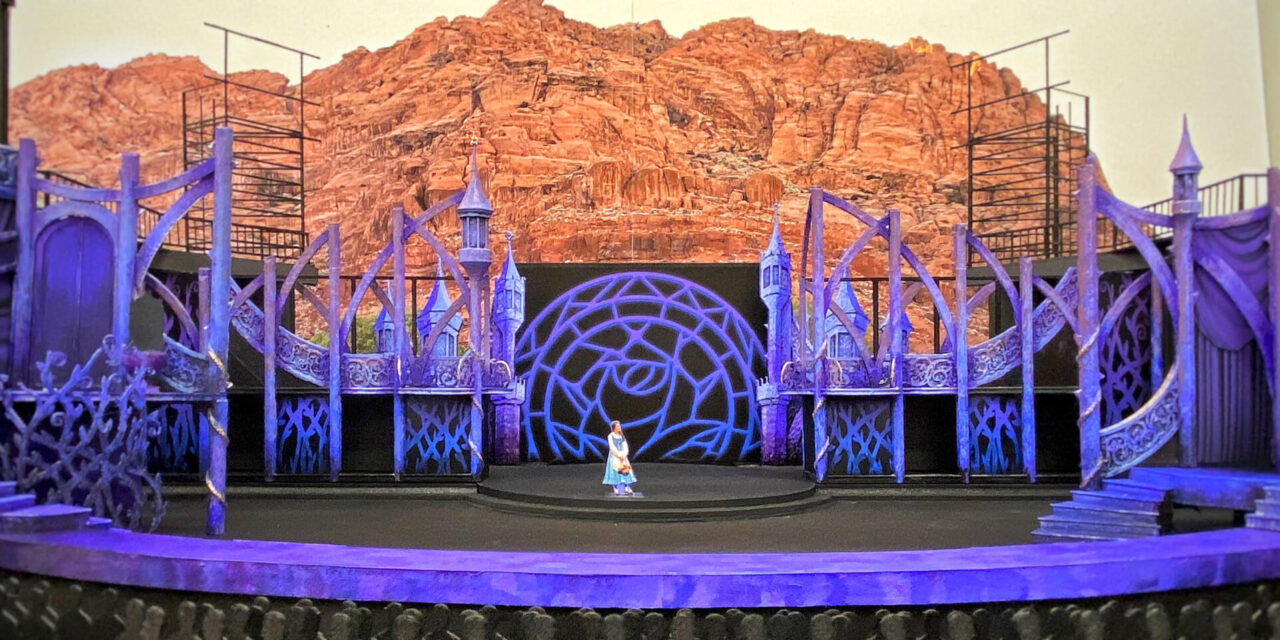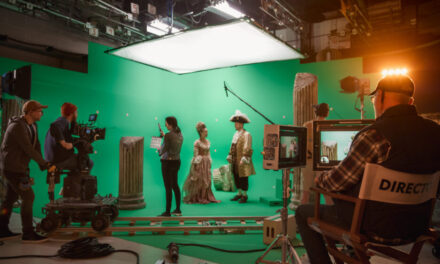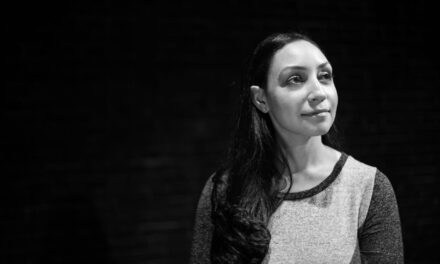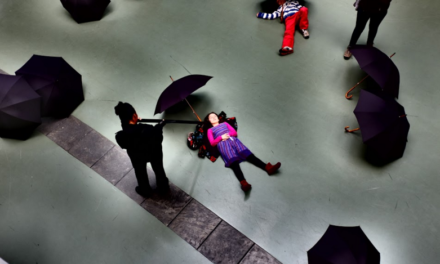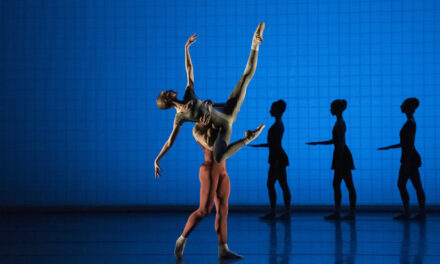For Part 2 see here.
Located in Southern Utah, the majestic Tuacahn Amphitheater has been the perfect summer treat for family audiences for over twenty-five years. This unique 2,000 seat amphitheater, with a 1,500 foot mountain cliff serving as its backdrop, was one of the first Equity theaters to return after the hiatus of the pandemic. With the assistance of Actor’s Equity, in addition to health and state officials, the theater was able to return to their cavalcade of gigantic blockbuster musicals this past May. The first musical within their four-show repertory, and the production that will remain open the longest throughout their season, is Disney’s Beauty and the Beast. I have invited the design team of Beauty and the Beast – Adam Koch, the set designer, Steven Royal, in charge of video projections and Cory Pattak, the lighting designer – to talk about their experience creating a theatrical design for an unorthodox theater space in addition to working for a theater company under COVID-19 safety protocols. I first begin this conversation with Mr. Koch from his home in Ohio:
Colden Lamb: What was the first show you designed for a specific outdoor theater space?
Adam Koch: The first show designed for an outdoor theater was Rodgers and Hammerstein’s Carousel at Atlanta’s Serenbe Playhouse in 2016. I would then go on to design Miss Saigon and Titanic in the following years. Designing outdoors in Atlanta felt like bungee jumping to me because once you feel the thrill of outdoor theater, your threshold for excitement is that much higher so you want to bungee jump twice as high. Doing those three musicals was terrifying at the time because I had more and a lot less to work with in many different ways but it gave me a deeper appreciation for outdoor theater. That same thrill of the challenge, I’ve applied to designing at Tuacahn Amphitheater.
CL: What did designing for an outdoor space teach you for future projects?
AK: Outdoor designing taught me the same as designing for nightlife music events. Lighting is really the key to outdoor performances. This is where lighting and scenery come together, as it should and always has. If a nightclub or outdoor space is not lit up somehow, it completely disappears by nightfall. A set is only as visible or impactful as the way it is lit.
It also taught me that designing for an outdoor space has a different set of building blocks. A traditional proscenium stage has a confined and definitive architecture to fill. The designs for outside venues, such as the landscape of Tuacahn for example, have to be amped up because it’s against the vault of the sky itself – everything else feels minuscule compared to it. The outside theater is also inherently abstract because you’re outside the confines of what you think will be a realistic picture. Very few shows take place in a red desert canyon, so already you’re in an imaginative world where you can be more suggestive and unexpected because the natural setting where you are watching the show is already abstract to begin with.
I now consider indoor theater easier compared to the possibilities of outdoor theater. The indoor theater is the opposite of dangerous, it’s lawful and artistically safe. With outdoor theater, you have possibilities of having an actual carousel on stage, a real helicopter landing in front of the audience, a lake in which passengers get into lifeboats or have explosive special effects, which are all safe as well, but feel dangerous.
CL: What was the first show you designed at Tuacahn?
AK: The first of three musicals at Tuacahn was Rodgers and Hammerstein’s Cinderella for their 2018 season. The first show you do at any theater sometimes feels like the best because you don’t know the rules or what to expect and Tuacahn has been one of the most unique settings that I’ve ever worked in.
I’ve been able to live out my dreams out at Tuacahn having the opportunity to design in an outdoor space that encourages me to dream big and to look at the ground plans of the stage with complete subjectivity as opposed to objectivity. At the start of the initial design meeting, Scott Anderson (the artistic director of the company) and his team encouraged the designers to dream big and they really meant it. And for what it’s worth, those set designs I’ve done out at Tuacahn with my associate Steven Royal, turned out very well because of that ability to dream big.
CL: What did you learn designing Cinderella that helped you the following times designing out at Tuacahn?
AK: Essentially I learned to tap into my childhood wonder and take advantage of the multiple playing spaces that are into the Tuacahn stage.
Here is an example. Tuachan has two rock formations on either side of the stage. The space is so wide and an audience’s peripheral vision can only take in so much at once. I tackled this issue by going back to the kind of set up present in a classic Chuck-E-Cheese’s animatronic stage show. Like Tuachan, Chuck-E-Cheese has one main stage with smaller ones on each side. You’d think that it wouldn’t be sophisticated because scenes aren’t typically that location specific. However, this time for Beauty and the Beast, I grounded two sets on each side of the stage; Belle’s bedroom on stage left and the Beast’s West Wing on stage right, leaving the main stage to be a flexible performing area. These two locations have small repeated scenes throughout the show and I didn’t want to put them on wagons because it would have been so clunky to continuously bring them on and offstage.
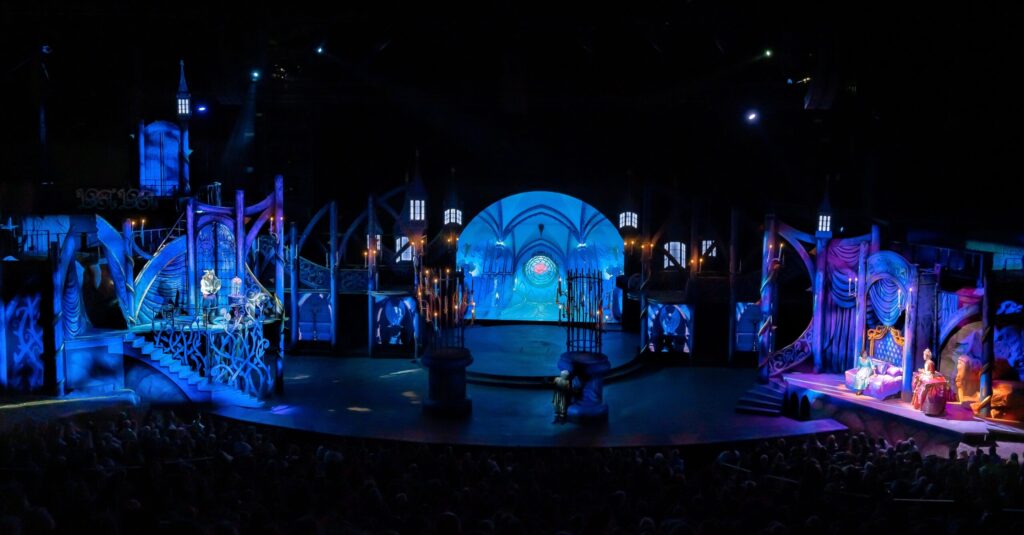
Nathaniel Hackmann, Benjamin Howes, Crystal Kellogg and Terra C. Macleod in Tuacahn Ampitheater’s production of Disney’s Beauty and the Beast. Set Design by Adam Koch, Lighting Design by Cory Pattak, Video Projections by Steven Royal, Choreographed by Robbie Roby and Directed by Michael Heitzman. Photo credit and permission by Cory Pattak.
CL: Would you care to discuss your creative process for this production of Beauty and the Beast?
AK: As designers, we have to interpret the script, understand which characters are coming and going, the pace, and if it’s a musical, listen to the score to understand it’s rhythm. I work through the script in an artistic and practical sense to get a feeling of the show, especially if it’s a musical that incorporates magic, such as Beauty and the Beast, because there’s going to be a thousand little tricks along the way that have to be accounted for. Every set designer is kind of a director and every director is a kind of set designer. You should have a good sense of how things should be staged and how stage pictures should look. This is not to undermine the director’s job but rather to look out for them and smooth out a path for them.
Then, I create a huge show flow chart with all of the elements that are contained in all the scenes. Following that, I make a stage diagram using a still image of the stage, plot through the show, sketch it out, and storyboard.
The set for this production of Beauty and the Beast at Tuacahn is a unit set. It looks grand and feels like it goes to many different locations but really, it’s simply one giant set depicting the Beast’s castle. After mapping out the show scene by scene, I realized that 80% of this musical takes place in or around the castle. Therefore, I decided to make the stage the world of the Beast, and Belle’s small provincial town inside of that world.
I designed the unit set to be halfway between a castle and a forest so when we transition from the castle to the provincial town, the scenes could blend together in harmony. I was inspired by cathedral architecture in which columns and arches were the stone mason’s way of interpreting trees, therefore the columns and arches that are in our set are like trees and branches. Cory Pattak, the lighting designer, also assists blending the set through the use of his lighting by using color palettes and texture for the village sequences, which helps the audience not even notice the castle elements of the set.
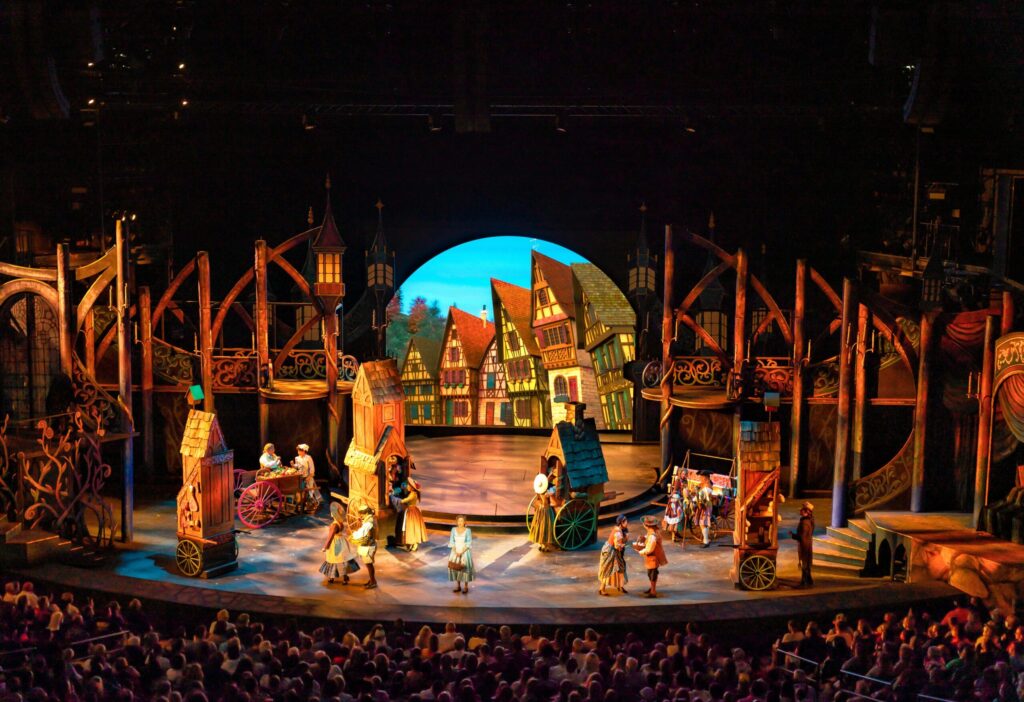
Crystal Kellogg and the company of Tuacahn Ampitheater’s production of Disney’s Beauty and the Beast. Set Design by Adam Koch, Lighting Design by Cory Pattak, Video Projections by Steven Royal, Choreographed by Robbie Roby and Directed by Michael Heitzman. Photo credit and permission by Cory Pattak.
For my color palette, I chose watercolor blue and purple for the architecture because it spoke to me as a musical version of castle cobblestone grey. The colors of blue and purple create a spooky, mysterious yet elegant atmosphere. Being Beauty and the Beast, it had to be between imposing and beautiful. Those two colors also helped make all the town’s set dressings of brown, amber, and timber colors stand out.
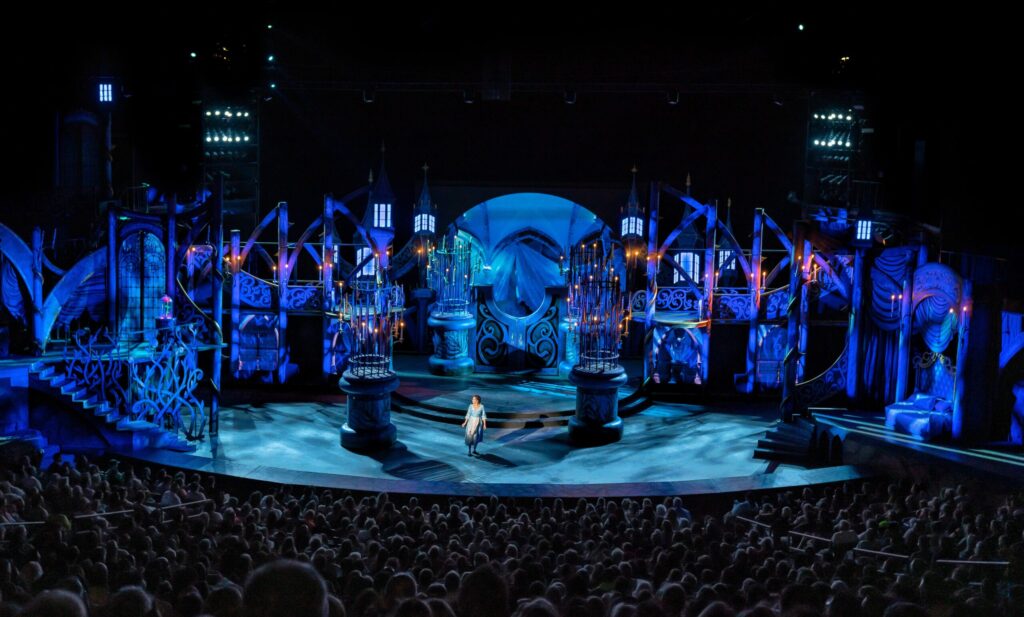
Crystal Kellogg in Tuacahn Ampitheater’s production of Disney’s Beauty and the Beast. Set Design by Adam Koch, Lighting Design by Cory Pattak, Video Projections by Steven Royal, Choreographed by Robbie Roby and Directed by Michael Heitzman. Photo credit and permission by Cory Pattak.
CL: When Tuacahn Amphitheater began doing shows about twenty-five years ago, the only backdrop they had was the gigantic red canyon wall. As the years pass with different musicals, the scenic design elements have either been trying to hide or showcase the canyon wall. Your design for Beauty and the Beast hides it. Do you care to discuss the reason behind this choice?
AK: My reasoning behind this choice has to do with the scale of the space. It takes a lot of scenery to make the stage feel full, even with a forty person cast. Therefore, I think it’s easier for a show to feel grandiose if the set tightens in the reins of the space. This also helps to make it feel like there are thousands on stage for big production numbers. One way I tightened my sets for all the shows I’ve designed for Tuacahn was by decorating the sides of the stage. In Cinderella, the sides were decorated to represent the village square, in The Little Mermaid each side was adorned with seashells and rainbows and in Beauty and the Beast it was locations within the Beast’s castle.
It also depends on the show, artistically. If I was going to design Oklahoma! or Crazy for You out at Tuacahn, I would allow the space to be open to the red canyon backdrop because it would be the natural kind of vista to savor for those types of musicals. Also, once it becomes nightfall out there at Tuacahn, it feels like you’re in an indoor theater. Therefore, if you leave the upstage open to that back area without scenery, it just feels dark, open, or too big. Not only do the settings for all four shows in repertory this year at Tuacahn have no relation to a desert canyon, I felt like we should create a world of our own that feels completely encased. Once it’s dark and the lights are on, that’s all the audience is going to focus on anyway, discounting the times Cory lights up the canyon walls for an effect beyond the set and it comes as a surprise because the audience had forgotten about it being there in the darkness.
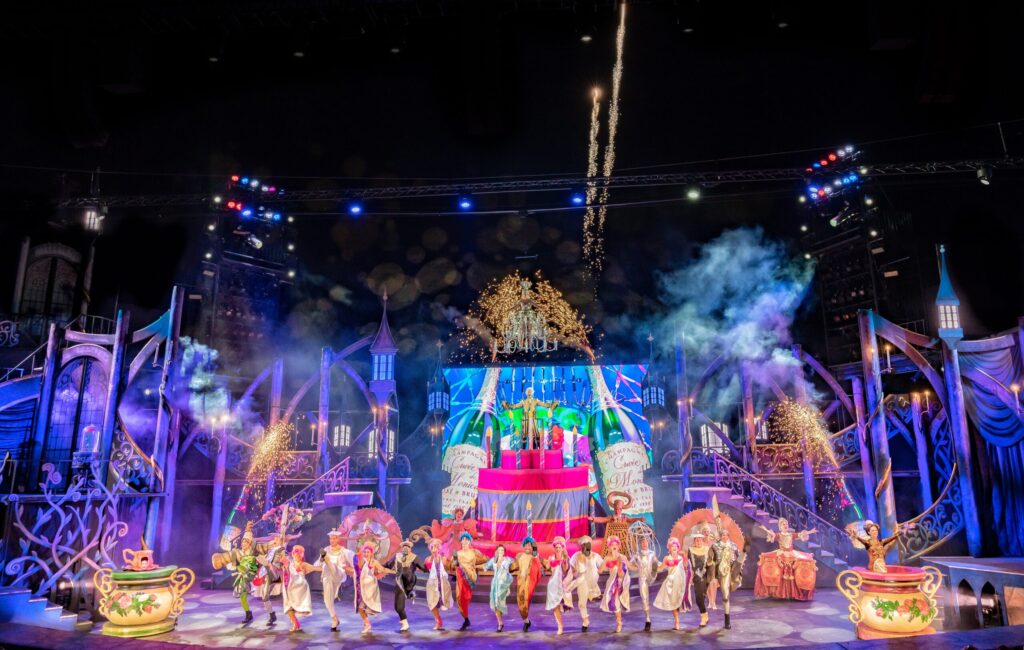
The company of Tuacahn Ampitheater’s production of Disney’s Beauty and the Beast. Set Design by Adam Koch, Lighting Design by Cory Pattak, Video Projections by Steven Royal, Choreographed by Robbie Roby and Directed by Michael Heitzman. Photo credit and permission by Cory Pattak.
CL: Do you care to comment about designing a set that had to be continuously set up and taken down for months on end?
AK: It was something that had to be considered in the design. One could be selfish as a set designer and not put that into consideration but ultimately the ability for the carpenters to tear down and put up the set without damaging the set every time is going to come back to haunt you one way or the other. The entire set itself is just flats and platforms. It’s my favorite kind of illusion. I devised this whole vista as this complicated maze of columns and arches but it is essentially flat layers.
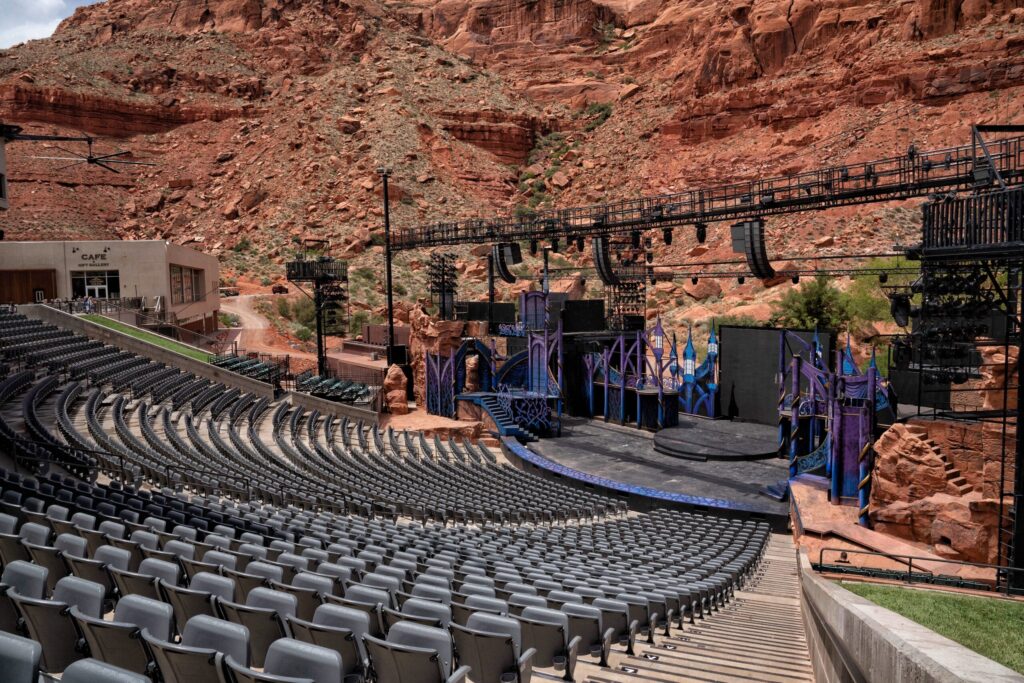
The stage of Tuacahn Ampitheater’s production of Disney’s Beauty and the Beast. Set Design by Adam Koch, Lighting Design by Cory Pattak, Video Projections by Steven Royal, Choreographed by Robbie Roby and Directed by Michael Heitzman. Photo credit and permission by Cory Pattak.
CL: What was your experience like designing and doing tech under COVID-19 protocols?
AK: As we have all experienced this past year, if you do anything long enough you get used to it. Therefore, doing tech under safety protocols and socially distant was not a big imposition. The only difference doing tech at Tuacahn this year was the addition of wearing masks, being socially distant and getting tested, which was for everyone’s good. When the actors were safely permitted to take their masks off and perform the show, it was a terrific surprise because it was like watching a whole other show. The cast was funny and all the jokes started to land. It made me realize how much comedy comes from seeing people’s mouths.
CL: Is there anything else you’d like to discuss or mention about your experience with Tuacahn?
AK: Before working on the outside productions at Serenbe Playhouse, I never thought I would do outdoor shows because they would not be compelling nor exciting. However, I have found the complete opposite to be true. Outdoor theater allows you to have the ability to do things you could never do in an indoor theater such as water, fire, live animals or explosions.
When Tuachan opened its doors to the public for its first preview performances of Beauty and the Beast, it was thrilling for me to watch the audiences see all of our moving parts come together, especially after a year of theaters being shut down. It was also heartwarming to see young children come to the theater dressed up as their favorite Disney characters, “ooo-ing” and “ahh-ing” as a horse came on the stage or when the fireworks went off. I felt proud that I was a part of this gift we could give the local audiences and that they really appreciated it.
Furthermore, I wanted to congratulate Tuachan for really stepping up to the plate in regards to having the gumption, resources, and bravery to attempt what everyone thought would be unthinkable or unsafe. Their organizational ability to put on a show was utterly amazing.
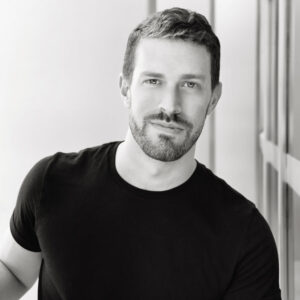
Adam Koch. Photography by Curtis Brown. Permission by Adam Koch.
Over the past several years Adam’s definitive set designs for theater, opera and nightlife have been seen in New York City and across the country.Theater credits include commercial productions at The Goodman Theatre, The Apollo Theater, New World Stages, and Theatre Row NYC, as well as Signature Theatre, Ford’s Theatre, Ogunquit Playhouse, Lyric Theatre of Oklahoma, Syracuse Stage, Portland Stage, Geva Theatre Center, Paper Mill Playhouse, Bucks County Playhouse, Serenbe Playhouse, Casa Manana, Playhouse on the Square, 1st Stage, The Human Race Theatre Company, The Engeman Theater, Mazeppa Productions, Algonquin Arts Theatre, Metro Stage, Bristol Riverside Theatre, The Gateway Playhouse, Vital Theatre Company, Brevard Opera Festival, Manhattan Youth Ballet, Wright State University, Queens College, and Montclair State University. A 2015 Helen Hayes nominee for Outstanding Set Design (1st Stage Theatre’s Bat Boy), a 2015 Syracuse SALT Award nominee (Syracuse Stage, Hairspray), and a 2009 Helen Hayes nominee for Outstanding Set Design (Signature Theatre’s Kiss of the Spiderwoman). A recipient of both the USITT Oren Parker Award for Excellence in Scene Design, and the 2007 Kennedy Center Design Fellowship. Adam is a graduate of Carnegie Mellon University and a member of the Andrew Carnegie Society. Mr. Koch is a credited contributor to the widely used collegiate textbook ‘Scene Design and Stage Lighting’ by R. Craig Wolf & Dick Block (Wadsworth 2009 – 2014). adamkochassociates.com
Colden Lamb is a Southern California-based actor. He graduated from San Diego State University. coldenlamb.com
This post was written by the author in their personal capacity.The opinions expressed in this article are the author’s own and do not reflect the view of The Theatre Times, their staff or collaborators.
This post was written by Colden Lamb.
The views expressed here belong to the author and do not necessarily reflect our views and opinions.

